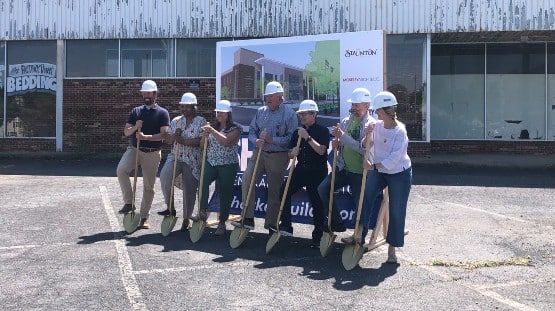
The Erie Canal sought to connect the Atlantic seaboard to the heartland of America, reducing shipping times and costs. Still, many thought the Erie Canal project was too expensive. But the canal was completed swiftly and on budget, meandering through 363 miles of rugged land. What had once taken three weeks to ship now took seven days. What once cost $100 now cost $6. Most importantly, the Erie Canal connected Europe with the center of America, fueling commerce and population movement.
By today’s comparisons, the footprint of the Erie Canal may seem small, but it cemented the idea that innovative, smart infrastructure fuels our economy.
Infrastructure projects aren’t always glamorous to talk about, but a solid infrastructure system is an important cornerstone in the foundation of our economy. Our roads, bridges, tunnels, canals, and ports keep our country moving. And here in Virginia, they are a lifeline to our economy.
We rely heavily on strong transportation and infrastructure systems in Virginia. In fact, Hampton Roads has been called the most infrastructure dependent place on the East Coast because of our reliance on bridges, tunnels, and roads. That dependence brings great opportunity. Our infrastructure allows us to move goods and cargo in and out of the Commonwealth every day. Our ports, rail lines, and roadways makes Virginia an attractive place for manufacturing companies, warehouses, and retail stores that can move their goods and supplies effectively and efficiently. Our interconnected transportation system supports our agricultural system, giving our farmers the products they need. Our ports and waterways allow our national defense access to critical international waterways in a matter of moments.
Over the past decade, the Hampton Roads region has emerged as a linchpin to support a larger ecosystem of commerce and national security. More than 17,000 trucks enter and exit Hampton Roads each weekday. Roughly 33% of the cargo that passes through Hampton Roads, in and out of the Port, moves by rail; the largest percentage of any U.S. East Coast port. And the tonnage of goods that will be moved to, from, and within Hampton Roads could jump 80% over the next three and a half decades. With the Panama Canal Expansion, the Hampton Roads region is poised to receive even more goods.
These are all exciting developments, but along with these opportunities is the very real challenge of maintaining and growing our infrastructure systems. In part, our region’s future depends greatly on how smart we are about planning for the future.
A Growth Mindset
The Port of Virginia is one of the few deep-water ports in the United States that can accept large ships. As international shipping, transport, and trade increase – especially with the Panama Canal Expansion –it’s critical our ports are equipped to take full advantage of those economic opportunities. In Congress, I serve on the Congressional Ports Caucus, a group that brings together minds from both sides of the aisle to think intelligently about impending growth, and be strategic in how we can strengthen our nation’s ports so we can remain a leader in commerce and transportation. I have also worked with members of the Virginia delegation to support initiatives like the eastward expansion of Craney Island. This expansion is critical to the Port’s future and its ability to handle future increases in cargo volume, keeping the Port and Hampton Roads competitive as a global economic hub.
Minimizing Choke Points
Our transportation systems support diverse priorities, but at the end of the day, people want roadways that keep us moving. Businesses need access to roads, bridges, and tunnels to move goods. Commuters don’t want to sit in traffic. This requires us to minimize choke points. For our region, that includes expanding the Chesapeake Bay Bridge Tunnel, making Raleigh to Norfolk a high priority corridor for future interstate, and replacing the Deep Creek Bridge, among other priorities. It also means giving States the resources and authority they need to identify these bottlenecks and work with localities and local commissions to determine the most efficient way to resolve them. Legislation like the recently approved FAST Act, which reforms transportation programs and provides more flexibility to state and local governments, takes significant strides toward providing the resources and authority needed to reinvest in our nation’s roads and bridges.
Unraveling Red Tape
It’s no secret that when the federal government gets involved, forward movement typically comes to a screeching halt. That shouldn’t be the case. I believe the federal government should act as an enabler to economic success, not a barrier, and no infrastructure project – especially those vital to commerce in a region dependent on infrastructure – should be held up unnecessarily because of some bureaucratic rule. That’s why I introduced my 414 Plan, which does a couple of key things to expedite the construction of roads and bridges: 1) It suspends for five years all federal regulations that don’t pertain to the safety of highway facilities, or of public and workplace safety; 2) It gets rid of costly, outdated federal requirements that often hold these projects up; and, 3) It continues to afford states and localities flexibility in utilizing federal funding for construction projects that make the most impact for their local communities.
Our infrastructure here in Virginia represents forward movement, entrepreneurship, and a global footprint. Our infrastructure speaks to our region’s future. By continuing to make smart investments in our infrastructure, we will enjoy even greater economic growth and opportunities for Virginia in the decades to come.
Randy Forbes represents the Fourth District of Virginia in Congress.










